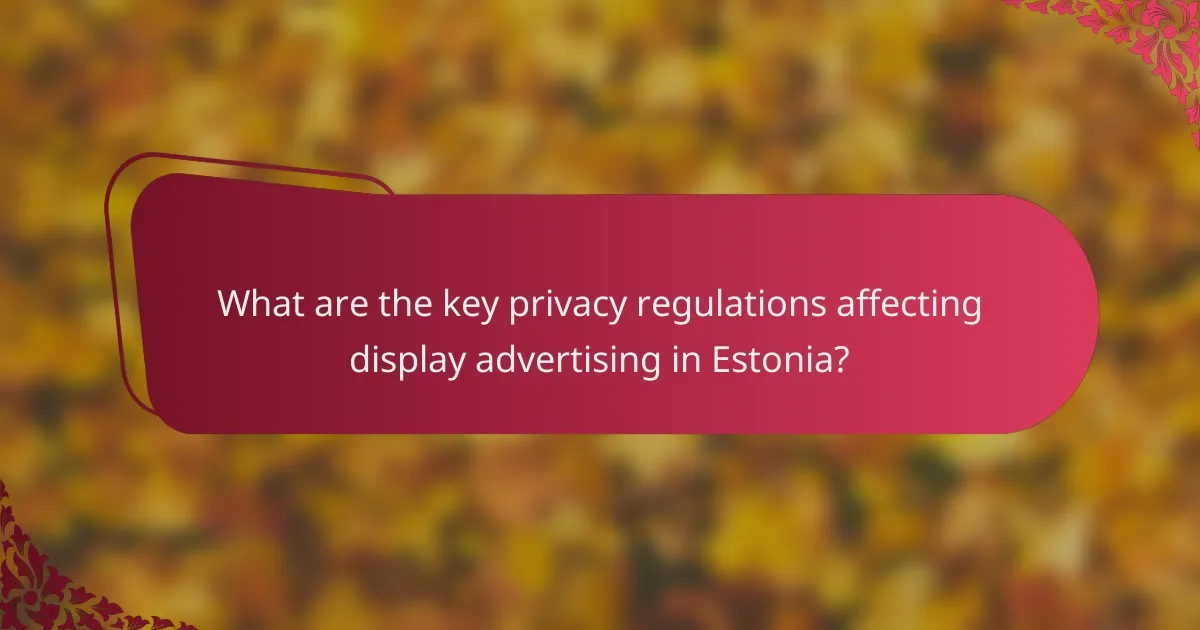Display advertising in Estonia is governed by stringent privacy regulations, primarily the General Data Protection Regulation (GDPR), the ePrivacy Directive, and the Estonian Data Protection Act. These laws dictate how personal data can be collected and utilized, emphasizing the importance of user consent and transparent data handling practices. To avoid significant penalties and reputational harm, businesses must implement effective data protection strategies and remain compliant with these regulations.

What are the key privacy regulations affecting display advertising in Estonia?
In Estonia, the primary privacy regulations impacting display advertising include the General Data Protection Regulation (GDPR), the ePrivacy Directive, and the Estonian Data Protection Act. These regulations set strict guidelines on how personal data can be collected, processed, and used in advertising practices.
General Data Protection Regulation (GDPR)
The GDPR is a comprehensive regulation that governs data protection and privacy across the European Union, including Estonia. It requires businesses to obtain explicit consent from users before collecting or processing their personal data for display advertising purposes.
Advertisers must ensure transparency by informing users about what data is collected and how it will be used. Non-compliance can lead to significant fines, often amounting to a percentage of annual global turnover, emphasizing the need for strict adherence to these regulations.
ePrivacy Directive
The ePrivacy Directive complements the GDPR by focusing specifically on privacy in electronic communications. It mandates that consent must be obtained before storing or accessing information on a user’s device, such as cookies used in display advertising.
Advertisers should implement clear cookie consent banners that allow users to opt-in or opt-out of data collection. This directive aims to enhance user privacy and control over their personal information in the digital landscape.
Estonian Data Protection Act
The Estonian Data Protection Act aligns with the GDPR but also includes specific provisions tailored to the local context. It outlines the responsibilities of data controllers and processors in Estonia, emphasizing the need for data protection impact assessments for certain types of processing activities.
Businesses engaged in display advertising must familiarize themselves with these local regulations to ensure compliance. Regular training and updates on data protection practices can help mitigate risks associated with non-compliance.

How can businesses ensure compliance with privacy regulations?
Businesses can ensure compliance with privacy regulations by implementing robust data protection strategies and adhering to legal requirements. This involves understanding applicable laws, obtaining user consent, and regularly assessing data handling practices.
Implementing consent management platforms
Consent management platforms (CMPs) help businesses collect and manage user consent for data processing activities. These tools enable organizations to present clear options to users regarding their data preferences, ensuring compliance with regulations like the GDPR.
When selecting a CMP, consider factors such as ease of integration, user interface, and reporting capabilities. A good CMP should allow users to easily modify their consent choices and provide businesses with clear records of consent.
Regular data protection impact assessments
Conducting regular data protection impact assessments (DPIAs) is crucial for identifying and mitigating risks associated with data processing. DPIAs help businesses evaluate how their data practices affect user privacy and ensure compliance with relevant regulations.
To perform an effective DPIA, outline the data processing activities, assess potential risks, and determine measures to mitigate those risks. It is advisable to conduct these assessments whenever there are significant changes to data processing activities or new technologies are implemented.

What are the penalties for non-compliance in Estonia?
In Estonia, penalties for non-compliance with privacy regulations can be significant, including hefty fines and reputational damage. Organizations must adhere to the General Data Protection Regulation (GDPR) to avoid these consequences.
Fines under GDPR
Under GDPR, fines for non-compliance can reach up to 4% of a company’s annual global turnover or €20 million, whichever is higher. This means that even small businesses can face substantial financial penalties if they fail to protect personal data adequately.
Estonian authorities enforce these fines rigorously, and organizations should ensure they have robust data protection measures in place. Regular audits and compliance checks can help mitigate the risk of incurring these fines.
Reputational damage
Non-compliance with privacy regulations can lead to severe reputational damage for businesses in Estonia. Customers are increasingly aware of their data rights and may choose to take their business elsewhere if they feel their information is not being handled responsibly.
To maintain trust, organizations should prioritize transparency in their data practices and communicate clearly about how they protect user information. Engaging in proactive public relations strategies can also help rebuild trust if a breach occurs.

What best practices should display advertisers follow?
Display advertisers should prioritize transparency, compliance, and ongoing education to effectively navigate privacy regulations. Implementing clear data collection policies and ensuring staff are well-trained on compliance are essential steps to build trust and avoid legal pitfalls.
Transparent data collection policies
Transparent data collection policies are crucial for display advertisers to inform users about how their data is being used. Advertisers should clearly outline what data is collected, the purpose of the collection, and how it will be shared or sold. This can be achieved through straightforward privacy notices and consent forms.
For example, a website could use a pop-up that explains data collection practices in simple language, allowing users to opt-in or opt-out easily. Providing users with control over their data fosters trust and can lead to higher engagement rates.
Regular training for staff on compliance
Regular training for staff on compliance with privacy regulations is essential for maintaining adherence to legal standards. Employees should be educated on relevant laws, such as the General Data Protection Regulation (GDPR) in Europe, and how these laws impact advertising practices. This training should be updated frequently to reflect any changes in legislation.
Consider implementing quarterly training sessions and providing resources such as compliance checklists. This ensures that all team members are aware of their responsibilities and can recognize potential compliance issues before they escalate.

How do privacy regulations impact ad targeting strategies?
Privacy regulations significantly influence ad targeting strategies by restricting how personal data can be collected and used. Advertisers must adapt their methods to comply with these laws, which often leads to a shift in focus from individual user data to broader targeting techniques.
Limitations on personal data usage
Privacy regulations, such as the General Data Protection Regulation (GDPR) in Europe, impose strict limitations on the collection and processing of personal data. Advertisers must obtain explicit consent from users before collecting their information, which can reduce the volume of data available for targeted advertising.
As a result, companies may need to rethink their data strategies, focusing on aggregated data or anonymized user profiles. This shift can lead to less precise targeting but may enhance user trust and compliance with legal standards.
Shift towards contextual advertising
With limitations on personal data usage, many advertisers are increasingly turning to contextual advertising. This approach targets ads based on the content of the webpage rather than user behavior or personal information, allowing for compliance with privacy regulations while still reaching relevant audiences.
Contextual advertising can be effective as it relies on the immediate context of the user’s environment. For example, placing ads for outdoor gear on a travel blog can attract users interested in related products without needing personal data. This method not only adheres to privacy laws but can also enhance ad relevance and engagement.

What tools can help with compliance in display advertising?
Several tools can assist businesses in ensuring compliance with privacy regulations in display advertising. These tools help manage user consent, assess compliance risks, and streamline the overall process of adhering to legal requirements.
OneTrust for consent management
OneTrust is a leading platform for managing user consent in display advertising. It allows businesses to create customizable consent banners that inform users about data collection practices and obtain their explicit permission.
Key features include automated consent tracking and reporting, which help ensure that businesses remain compliant with regulations like the GDPR and CCPA. Companies can easily adjust settings based on user preferences and regional requirements.
TrustArc for compliance assessments
TrustArc provides comprehensive compliance assessment tools that help organizations evaluate their adherence to privacy regulations. This platform offers risk assessments, gap analysis, and ongoing monitoring to identify potential compliance issues.
With TrustArc, businesses can generate detailed reports that outline compliance status and recommend actions for improvement. This can be particularly useful for companies operating in multiple jurisdictions with varying privacy laws.


